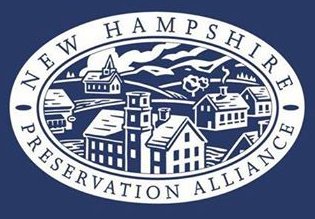Lyme Historians Working to Save a Local Landmark - one of 52 Barns in 52 Weeks
In Lyme, a group of enthusiastic and dedicated locals is working to restore an early 19th century English barn attached to the Churchill-Melvin House, at 15 Main Street, in the center of Lyme Plain Village. The Lyme Historians, which was organized in 1961 as a historical society and currently has nearly 300 members, purchased the landmark property in 2016 to serve as their new public museum. The group secured an assessment grant from the Preservation Alliance to map out a plan for the barn’s repair and conversion for educational use. The grant was made possible by donors to the 52 Barns in 52 Weeks campaign.
The New Hampshire Preservation Alliance is highlighting this barn and this community project as one of our 52 Barns in 52 Weeks because of the visibility and significance of the place, and the group’s commitment to preservation “best practices” as they incorporate the old barn into their plan for expanded program space.
The house was apparently built as the law office for Judge D. C. Churchill around 1850 (his home was across the Common). The first hundred years of owners—Churchills, Melvins, and Wests—were prominent citizens of this small town and also proprietors of the general store next door. Diaries indicate that nearly all of the locals shopped at the store, and photographs show a line of hitching posts along the boundary with the Churchill-Melvin House. The house and its barn have long been prominent buildings in town.
The attached barn adds to the idyllic landscape of this small New Hampshire village. Its close neighbors include the Old Cemetery, an historic line of horse sheds, the former town jail, and the white-steepled 1812 church on the well-used and beloved Common. The barn and house are contributing structures to the Lyme Common Historic District, listed on the National Register of Historic Places.
At present, structural and practical issues limit the options for using the barn to its full potential. Once rehabilitated, the Lyme Historians plan to use it for educational purposes, both as a good example of an early 19th century barn, and for exhibits or demonstrations of vintage farm-related items, as well as an event venue. The group received a mini-grant from the Preservation Alliance that provided for an evaluation by Richard M. Thompson of Sunrise Woodworks, of Cornish. Mr. Thompson gave them an oral report on his findings at the time of his visit, followed by a written summary as a guide for planning and restoration.
The attached, three-bay, modified English style (eaves entrance) barn, measures 30’ x 40’. The barn held horse stalls, and in the cellar, had stalls or pens for pigs or sheep and storage. Close inspection during Thompson’s assessment dates the barn to ca. 1810 (pre-dating the house). This means it was probably moved and attached to the new house around 1850, a time when bank barns became popular. Moving a barn was not uncommon at the time. Thompson was impressed by the massive, hand-hewn first floor beams that are well-preserved after 200 years.
The goal of 52 Barns in 52 Weeks is to help at least 52 barn owners across the state with assessment grants, assistance in securing tax relief, and educational opportunities to help save their historic barns. Throughout 2017, barns and their owners are being showcased by the Preservation Alliance to celebrate good work and offer practical information and inspiration to others.
We are grateful to all of our donors to date, and encourage others to add their support with an investment in the 52 Barns in 52 Weeks campaign so we can do more!
Check out the Lyme Historians’ website for hours and information on visiting the site or to follow the restoration progress: http://lymehistorians.wordpress.com. The Lyme Historians are being deliberate about their restoration planning, and the visibility of the project in the center of the village will serve as a “good practices” example.

